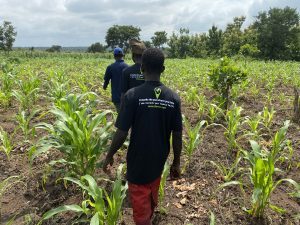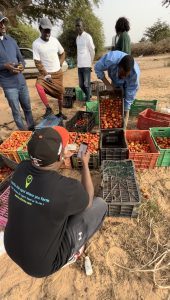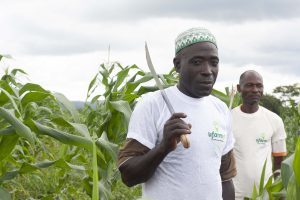While the tech and data driven solutions are impressive, I believe the key to our success lies in the methodology we have developed for community engagement and relationship building with our farmer partners. We build genuine relationships and remain engaged with our indigenous stakeholders, allotting them a stake in the model and design of our business.
Without giving away too much I will walk you through our ‘magical’ process. First our local agents directly engage farmer communities while utilizing our software application to collect roughly 20-30 data points on each farmer. These data points allow us to identify the challenges that they face on ground production wise. Then, a portfolio is created and through AI integration a tailor made package of inputs is curated for the farmer profile that will increase their production.
We are able to cut down costs and assure quality by linking farmers directly to the inputs needed to increase their yields, thereby eliminating several intermediaries. Utilizing QR codes and the blockchain ledger system, we transparently track the entire journey of your produce from seed to sale. Additionally, we organize the farmers into communal networks appointing a local agent as a lead to provide support. This support includes granting them access to certain infrastructural elements, such as solar powered storage facilities through partnerships and facilitating secure purchase orders to ensure a reliable offtaking process.
Over the next five years, we envision rapid expansion across the continent and beyond. Our goal is to onboard and empower a minimum of 12,000 farmers in 10 different markets, establishing a significant presence in the African agricultural sector. Our mission is to foster sustainable growth, reduce poverty, and transform rural communities, all while creating a steady revenue stream with scalability potential.
How Does Advanced First-mile Traceability Impact Supply Chain Transparency?
 In the Western world, luxuries such as being able to recall faulty food and trace it back to the source are often taken for granted. However, in the underdeveloped world, an outbreak of disease due to a contaminated food supply can have catastrophic consequences.
In the Western world, luxuries such as being able to recall faulty food and trace it back to the source are often taken for granted. However, in the underdeveloped world, an outbreak of disease due to a contaminated food supply can have catastrophic consequences.
UfarmX significantly enhances traceability in emerging markets, namely Africa, through our advanced approach. Here’s how:
1. Data Accuracy and Precision
By utilizing blockchain and advanced technology, UfarmX ensures precise and accurate data collection right from the first mile. This includes geolocation, farmer profiles, and images, and creating a detailed and reliable digital trail.
2. Immutable Record Keeping
The use of blockchain ensures that once data is recorded, it cannot be altered or tampered with. This immutability guarantees the integrity of the information collected at the first mile, providing a trustworthy foundation for the entire supply chain.
3. Real-time Visibility
Stakeholders in the supply chain, including farmers, distributors, and consumers, gain real-time visibility into the journey of agricultural products. This transparency builds trust and allows for informed decision-making.
4. Supply Chain Accountability
Advanced traceability holds each participant in the supply chain accountable. From input providers to farmers and distributors, every entity is part of a verifiable and transparent system, reducing the risk of fraud or unethical practices.
5. Consumer Confidence
As consumers become more conscious of the origin and quality of products, first-mile traceability ensures they can access reliable information about the products they purchase. This transparency enhances consumer confidence and loyalty.
So in summary, advanced first-mile traceability is a foundational element that positively impacts the entire supply chain by ensuring accuracy, transparency, and accountability at the initial stages of agricultural production.
I’m sure formalizing processes for rural smallholder unbanked farmers comes with a lot of logistical and mindset challenges.
What Are the Key Hurdles that You Have Had to (and are still trying to) Overcome?
 Navigating emerging markets without foundational infrastructure poses challenges, but witnessing real-time positive impact makes it all worthwhile.The key was unlearning Western perspectives. Initially, when starting UfarmX, I approached it with a traditional ‘Western academic lens,’ assuming that a thesis and data would seamlessly translate on ground. I failed to take into account local cultural nuances, and assumed I would be able to simply recreate western systems without adaptations.
Navigating emerging markets without foundational infrastructure poses challenges, but witnessing real-time positive impact makes it all worthwhile.The key was unlearning Western perspectives. Initially, when starting UfarmX, I approached it with a traditional ‘Western academic lens,’ assuming that a thesis and data would seamlessly translate on ground. I failed to take into account local cultural nuances, and assumed I would be able to simply recreate western systems without adaptations.
What I quickly learned through failure is, humility and taking into account human elements on the continent are paramount to success. Simply presenting the prospect of more money to someone that has managed to live life without is not an attractive proposition. Learning the lay of the land first-hand through personal engagement is essential, and integral relationships are key. At UfarmX, our approach is not simply extractive; we genuinely view our customers as our partners and not just bottom lines.
Fintech Insights: Leveraging the Power of Payments to Forge Better Employee Relations
What’s Your Take on Financial Inclusivity across Communities? How Can AI Enable that Vision?
Financial inclusivity is vital for community empowerment and AI plays a pivotal role in providing innovative solutions. With AI-driven credit profiling, UfarmX creates pathways for the unbanked to access institutional finance, promoting financial inclusivity. Our platform’s data-driven approach captures farmers’ information, enabling credit assessments based on performance. This, coupled with blockchain technology, establishes transparency, builds trust, and offers valuable insights to financial institutions. The integration of AI in our ecosystem transforms traditional banking barriers, fostering inclusivity and unlocking economic opportunities for underserved communities. Essentially, we help our farmers formalize their informal business practices.
What Has Been Your Biggest Learning in Building and Expanding Ufarmx®?

In the process of building and expanding UfarmX, I’ve come to realize that achieving success in emerging markets goes beyond academic theories and data-driven models. It is essential for the business approach to be collaborative, considering customers as partners rather than mere bottom lines.
I’ve learned that a hands-on understanding of the local landscape and cultivation of genuine connections are essential for navigating challenges and making a positive impact. Unlearning preconceived notions and adapting to the local cultural nuances and human elements are critcal for success. Humility and personal engagement are key components in developing integral relationships with the community.
What Are Your Five Key Predictions for AI in Agriculture the Next Few Years?
- Increased Adoption of Precision Agriculture: AI-driven precision agriculture tools will see widespread adoption. This will enable farmers to optimize resource use and enhance crop yields through data-driven decision-making.
- Advancements in Crop Monitoring and Disease Detection: AI applications will continue to evolve, providing more sophisticated crop monitoring and disease detection solutions. This will enable early intervention, reduce crop losses and ensure food security.
- Mechanized Farming Communities: The use of AI-powered robots in farming operations will increase, from planting and harvesting to weeding and monitoring. This automation lends opportunities to create entire robotized communities.
- Supply Chain Management: AI will play a crucial role in optimizing supply chain management for agricultural products. This includes predicting demand, improving logistics, and ensuring better market access for farmers.
- Predictive Analytics for Climate Resilience: AI-driven predictive analytics will become more sophisticated in forecasting climate patterns. This will help farmers adapt to changing conditions, manage risks, and make informed decisions for sustainable agriculture.
Read More About Fintech Interviews: Global Fintech Interview with Andrey Korchak, CTO at Monite
[To share your insights with us, please write to pghosh@itechseries.com ]
